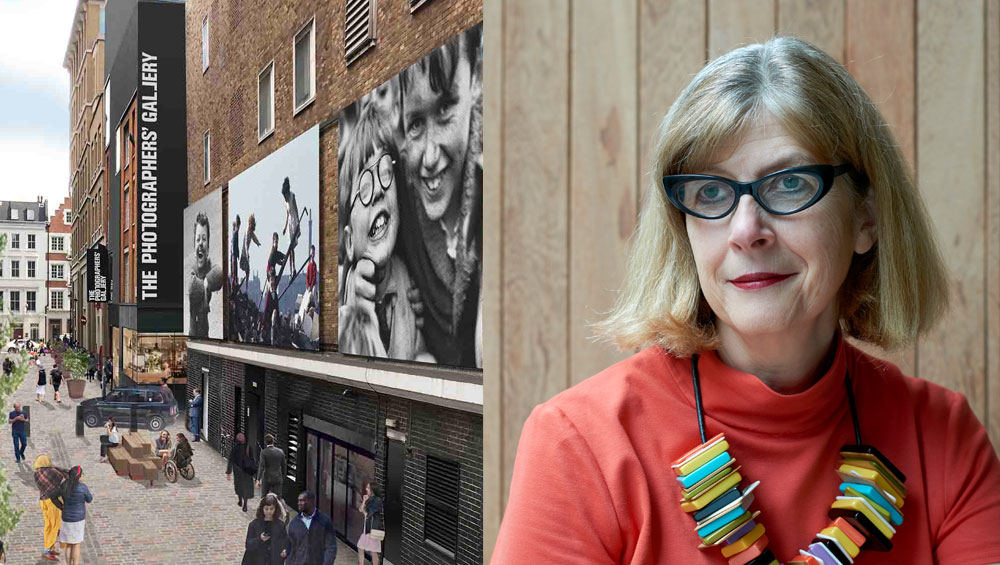
Brett Rogers, director of the Photographers’ Gallery.
by DAVID TRIGG
The Photographers’ Gallery is gearing up to celebrate its 50th anniversary this summer with an exciting programme of exhibitions and projects. Founded in 1971 by Sue Davies (1933-2020) as the UK’s first public gallery devoted to photography, the London-based venue has played a pivotal role in establishing the medium as a distinct art form. Its diverse programme has included work by many of the world’s most famous photographers and, after half a century, it is taking the time to look back at key moments in its rich history. In recent years, the organisation has been steered by Brett Rogers OBE (b1954, Brisbane), who joined as director in 2005. Her relationship with the gallery stretches back to her student days in the 1980s, when she was an avid visitor. In this interview, Rogers speaks to Studio International about her own passion for photography, the history and achievements of the Photographers’ Gallery, its 50th-anniversary programme and ambitious future plans.

Five Years with the Face, held at The Photographers’ Gallery, 19 April – 18 May 1985. Installation view. Exhibition design by Neville Brody with Robin Derrick Courtesy of The Photographers’ Gallery Archive, London.
Growing up in Australia, Rogers’ early exposure to photography was limited to news media and fashion magazines. Her interest in the medium was sparked in the early 1970s, towards the end of her fine arts degree at the University of Sydney, when a chance meeting with the curator of photography at the State Library of New South Wales resulted in an invitation to view some of its 19th-century archival images. “I was smitten,” enthuses Rogers, “not only by what these images revealed – and did not reveal – about the world, but by the extraordinary beauty and range of printing techniques of that era.” It was a watershed moment that led to an enduring fascination with the extraordinary history of photography and its significance as an art form. “Shortly thereafter I had the opportunity to expand my passion for the medium when I was offered the chance to curate exhibitions of contemporary photography for the first organisation I worked for, the Australian Gallery Directors’ Council.”
Arriving in London in 1980 to study at the Courtauld Institute of Art, Rogers was keen to broaden her horizons by being exposed to world-class art and culture. In those days, the Courtauld did not consider photography a suitable subject for academic study, a stance that deeply disappointed Rogers. “I had to opt to study an alternative subject that was also of interest to me: surrealism and its approach to exhibitions. This, of course, involved a lot of research using photographic documents as evidence. It was only in the late 80s that Valerie Lloyd [founding curator of the Royal Photographic Society collection] was given permission by the Courtauld to focus on photography as her primary PhD subject; and the result was, of course, her seminal research on the photographer Roger Fenton, which led to an exhibition at the Hayward Gallery. Things have thankfully moved on a great deal since 1980 and now students can freely study photography and new media at nearly all UK universities.”
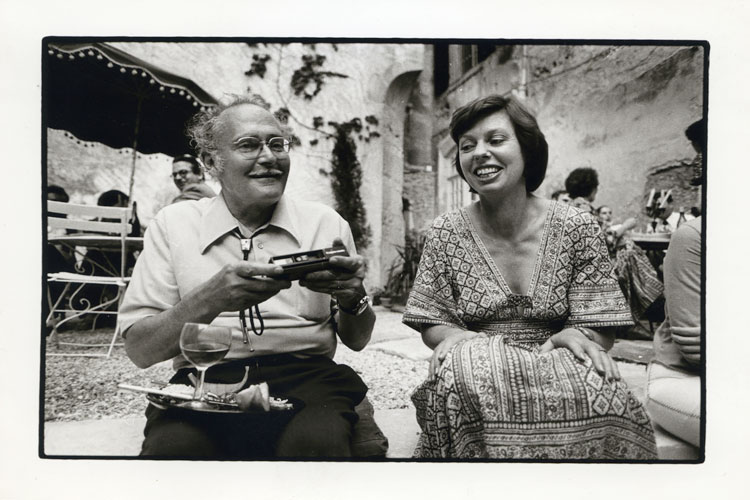
Sue Davies and W. Eugene Smith. Date unknown. Photographer unknown. Courtesy of The Photographers’ Gallery Archive, London.
Rogers was naturally drawn to the Photographers’ Gallery, which was then located on the edge of Covent Garden, and she has fond memories of the venue and its exhibitions. “It was one of my favourite places to visit,” she recalls. “I always enjoyed its welcoming, accessible character and the challenging nature of the work it showed.” Among many memorable exhibitions at the gallery, several made a particular impact on her, including the ambitious group show Floods of Light (1983), the first exhibition dedicated to the development of flash photography. Another was The Animal in Photography (1986), which brought together photographs of animals from all types of photography including fashion and advertising. “There was also Disrupted Borders (1994),” she remembers, “which marked the so-called emergence of a united Europe, and Chris Pinney’s remarkably prescient The Impossible Science of Being (1995), tracing the parallel histories of anthropology and photography.” The gallery has also been strongly committed to promoting the work of female photographers, especially from the 90s onwards. Before joining the organisation, Rogers remembers seeing outstanding exhibitions of Corinne Day, Isa Genzken and Lise Sarfati. As director, she has ensured that this legacy continues, programming solo shows by Sally Mann, Katy Grannan, Shirley Baker, Claire Aho, Tish Murtha and Laura Letinsky, among others.
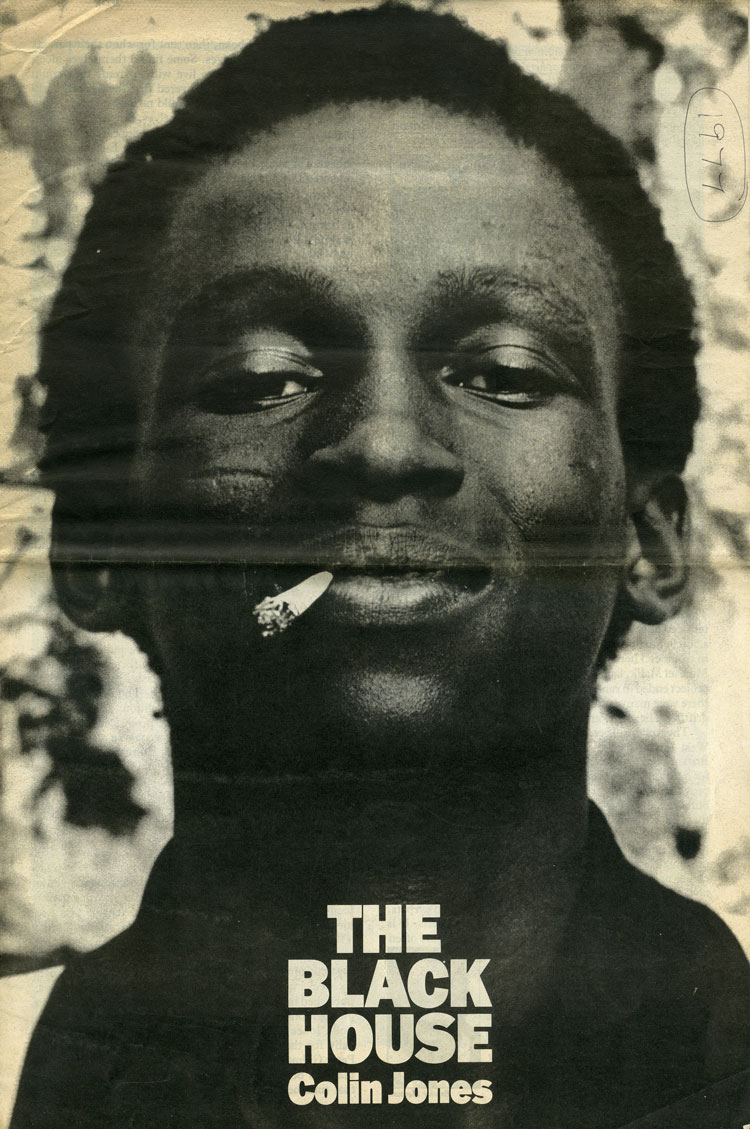
Exhibition Poster, Colin Jones: The Black House, held at The Photographers’ Gallery, 04 May – 04 June 1977. Courtesy of The Photographers’ Gallery Archive, London.
Before joining the Photographers’ Gallery, Rogers worked at the British Council as head of exhibitions in its visual arts department. While there, she was instrumental in developing its photography policy and programme, inspired in large part by Davies, whose vision for the Photographers’ Gallery resonated with her. Indeed, she greatly admired the fact that Davies founded the venue at a time when there was little appreciation or understanding of the role of photography as an art form. “Sue struggled to secure the money for the rent for the first few years,” she says. “She forewent her own salary for the first 18 months of the gallery’s life and eventually organised an auction with Sotheby’s in order to pay the bills. From the start, she lobbied the Arts Council and, by late 1972, the Photographers’ Gallery became the first photography gallery to be financially supported, albeit very modestly, by the Arts Council.”
The Photographers’ Gallery has always attracted a very loyal and engaged audience, which in 1981 led to the venue’s first expansion. A second gallery space, located two doors up on Great Newport Street, enabled the provision of extra exhibition space, a cafe and dedicated print sales gallery. “Sue’s ability to raise the necessary funds to purchase this building, while still renting the original space, provided us with the financial security to make the big move in 2008 to Ramillies Street,” says Rogers. The gallery’s third and current iteration is housed in a former textile warehouse behind Oxford Circus. The building was radically refurbished between 2010 and 2012, introducing three museum-standard galleries, a dedicated education floor and a bookshop.
After 50 years, the Photographers’ Gallery continues to go from strength to strength. Rogers is convinced that its longevity is due to the relevance that the photographic image continues to play in our everyday lives. “When I look back at the programme that Sue Davies introduced in 1971,” she says, “I notice that it is not that dissimilar from the programme we continue to offer today – always combining very accessible projects alongside some very challenging work. While Davies knew everyone would find no problem engaging with the work of David Bailey, André Kertész and Lord Snowdon, she would then exhibit work that questioned the nature of the medium. For example, when John Stezaker had his first exhibition in a public gallery with us in 1978, ‘traditional’ photographers were in uproar; they were so outraged that she chose to show the work of someone they accused of not even taking his own photographs, just recycling other people’s images!” Today, the gallery continues to encourage such debate, striving to be at the forefront of issues within contemporary photographic practice and image culture.

Sue Davies and Ralph Gibson. Date unknown. Photographer unknown. Courtesy of The Photographers’ Gallery Archive, London.
The Gallery’s 50th anniversary presents a salient opportunity to take stock of its achievements. Launching this summer, Light Years is a special four-part exhibition, curated by David Brittain, that mines the archives to explore important moments in the gallery’s history and photographic practice more broadly. “David is a highly regarded curator, writer, researcher and historian who has worked in the photographic field over many decades and has been closely associated with the gallery, both as a visitor, a reviewer and a curator,” Rogers says. “We felt his familiarity with the wider UK photographic scene, as well as his experience working in the photography press, through editing one of the UK’s legendary photo magazines Creative Camera (1991-2000) and elsewhere, brings a refreshing perspective to this re-examination of our history.”
“We have always kept ourselves open to how the 50th anniversary project could be manifested in the programme,” Rogers continues, “but we were keen to utilise some of the rich, and largely unseen, materials in our archive. As research progressed, the idea that the gallery’s history could be summed up in one exhibition became less appealing and, instead, we considered that a more discursive and multi-part series of displays over a longer period meant we could focus in on specific themes. Each of the four thematic ‘chapters’ will offer different insights into how the gallery’s programme helped to define its changing identity over the past 50 years.”
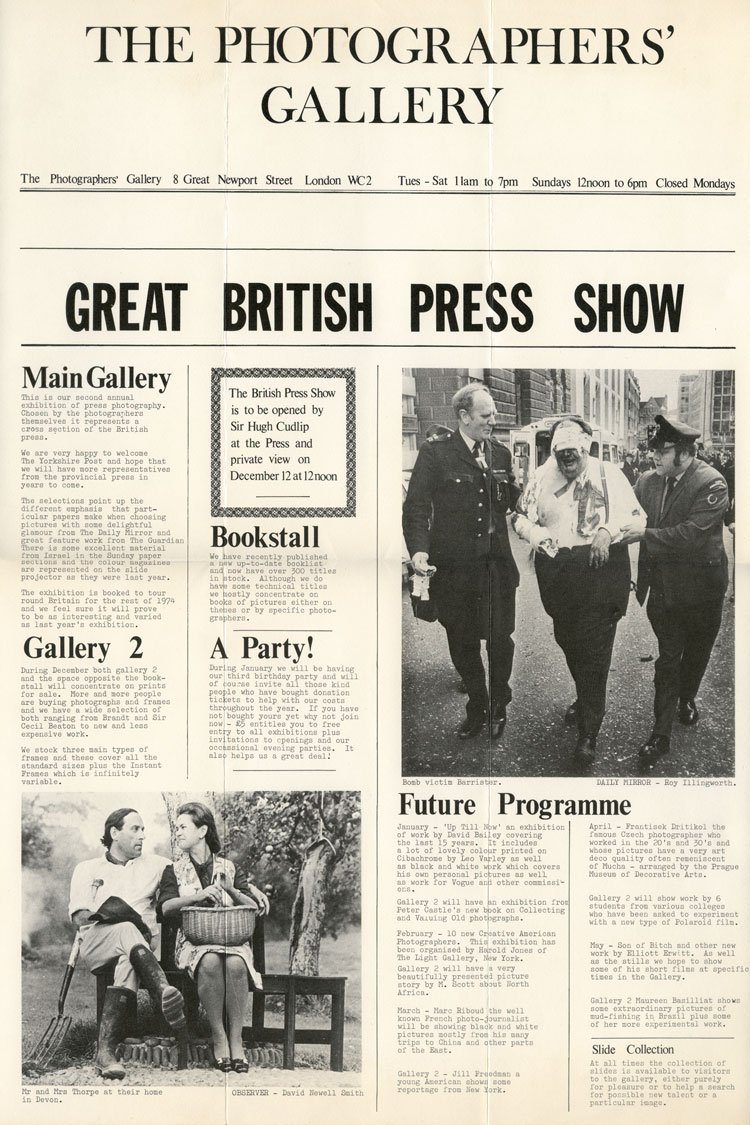
Exhibition Poster/Pamphlet, Great British Press Show, held at The Photographers’ Gallery, 05 – 29 December 1972. Courtesy of The Photographers’ Gallery Archive, London.
The first chapter, which opens this month, considers the gallery’s beginnings and the importance of documentary and photojournalistic practice to the early programme. “Reportage and news imagery have always been a critical element of the gallery’s programme,” Rogers says, “starting with our first exhibition, The Concerned Photographer, which opened in January 1971.” In August, the second instalment of Light Years will examine the gallery’s showcasing of commercial photography, looking at the many exhibitions with fashion and advertising photographers, such as the popular David Bailey retrospective in 1974 and the major 1985 collaboration with Neville Brody, Five Years with The Face, which affirmed the important role of magazines in promoting the work of photographers such as Anton Corbijn, Jill Furmansky, Sheila Rock and Robert Mapplethorpe. Part three examines the development of fine art photography and other experimental approaches, while part four draws on five decades of exhibitions at the gallery to focus on the links between technological and aesthetic innovation, as well as vernacular and non-art image-making, which have been key tools in understanding photography’s role in society.
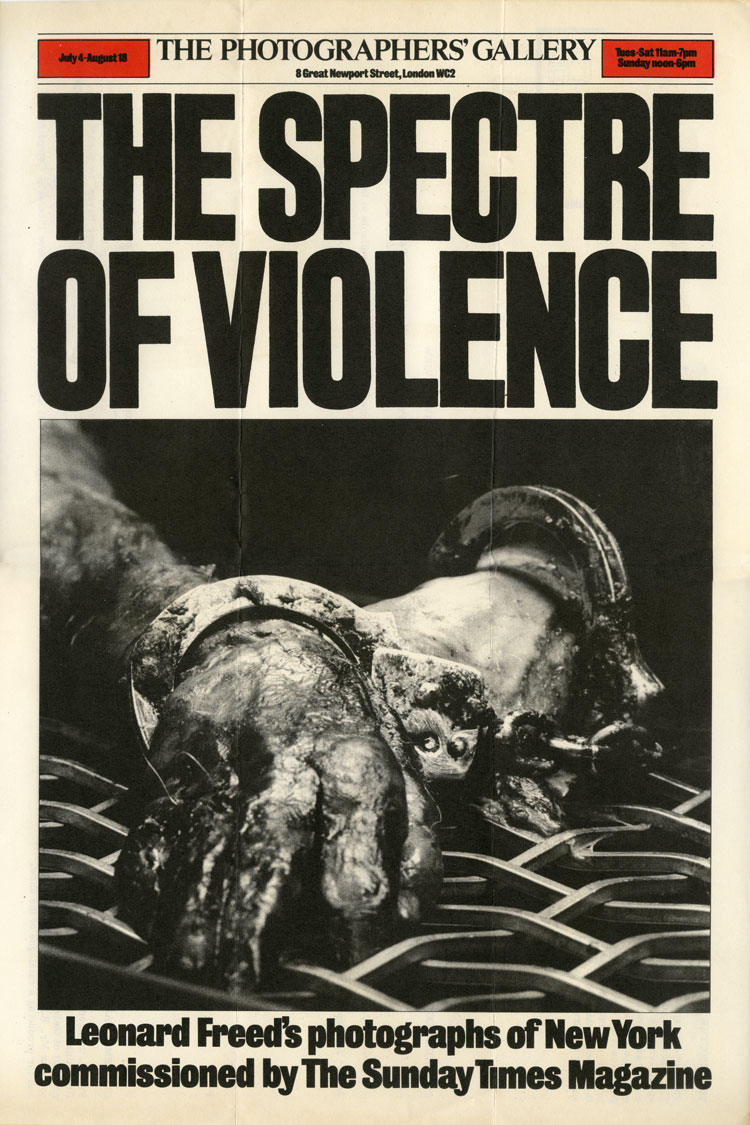
Exhibition Poster, Leonard Freed: The Spectre of Violence, held at The Photographers’ Gallery, 03 July – 18 August 1973. Courtesy of The Photographers’ Gallery Archive, London.
Research for Light Years revealed a string of fascinating insights. “David was surprised in general by what had survived,” says Rogers, “given that the organisation has always struggled with slender resources. The archive of photographers’ talks and lectures was particularly interesting because recordings give snapshots of the relative sophistication of the audiences that supported the gallery at different times, shedding light on the issues that mattered. Having read Sue Davies’s personal records as well as the official trustees’ minutes, I was particularly interested to learn more about the impact that certain American photography organisations, such as the Museum of Modern Art and the Fund for Concerned Photography in New York, had on our opening programme, alongside the formidable influence that major figures within the UK print media, such as Harold Evans, David Astor and Tom Hopkinson, had with regard to the programme and fundraising for shows; yes, money remained a really pressing issue from the start. I also realised that Sue Davies’s taste was central to setting the tone for the future programme – one that uniquely incorporated, right from the start, fashion, editorial and vernacular photography alongside experimental and ‘art’ photography. Identifying this continuity in the programme, which has continued up to today, was a very welcome discovery.”
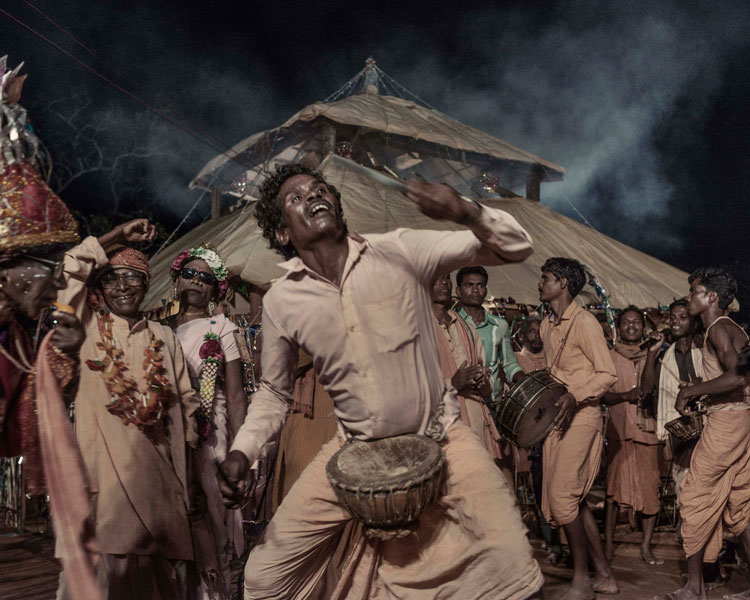
Poulomi Basu From Centralia, 2020 © Poulomi Basu. Courtesy of the artist
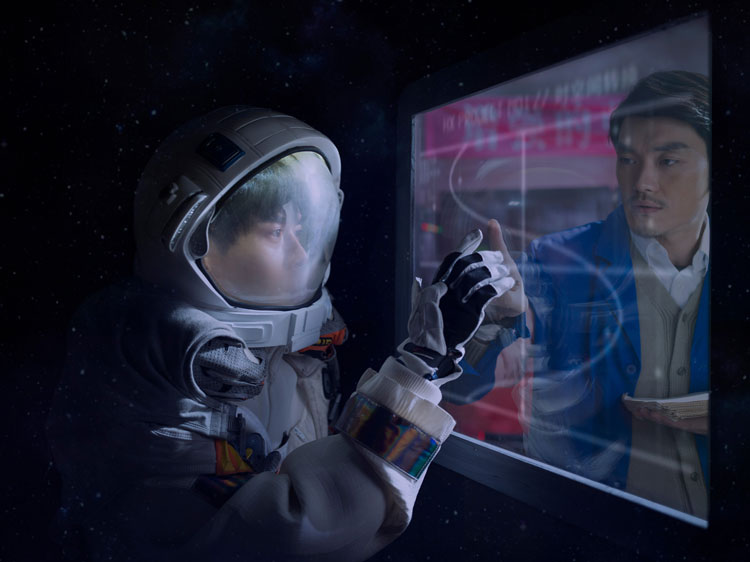
Cao Fei , Nova, 2019 . © Cao Fei. Courtesy of artist, Vitamin Creative Space and Sprüth Magers.
Alongside Light Years, the Photographers’ Gallery will again be hosting the Deutsche Börse Photography Foundation Prize, which each year takes the temperature of contemporary photography and this summer is celebrating its 25th edition. “More than ever, this year’s shortlist recognises the truly global nature of the medium with nominees from China, Mexico, India and Algeria/France,” Rogers says. “It also signifies that photography is no longer confined to being a specifically print- or wall-based medium. All these artists exemplify new possibilities of the photographic image – in book form [Alejandro Cartagena, Poulomi Basu], in moving image [Cao Fei] and through immersive installations [Zineb Sedira]. It is such an exciting time for the medium and we are confident the public will be fully engaged with the work of these four diverse nominees who deal with issues ranging from home ownership in Mexico and the impact of globalisation on work, to environmental destruction, gender rights and political violence.”
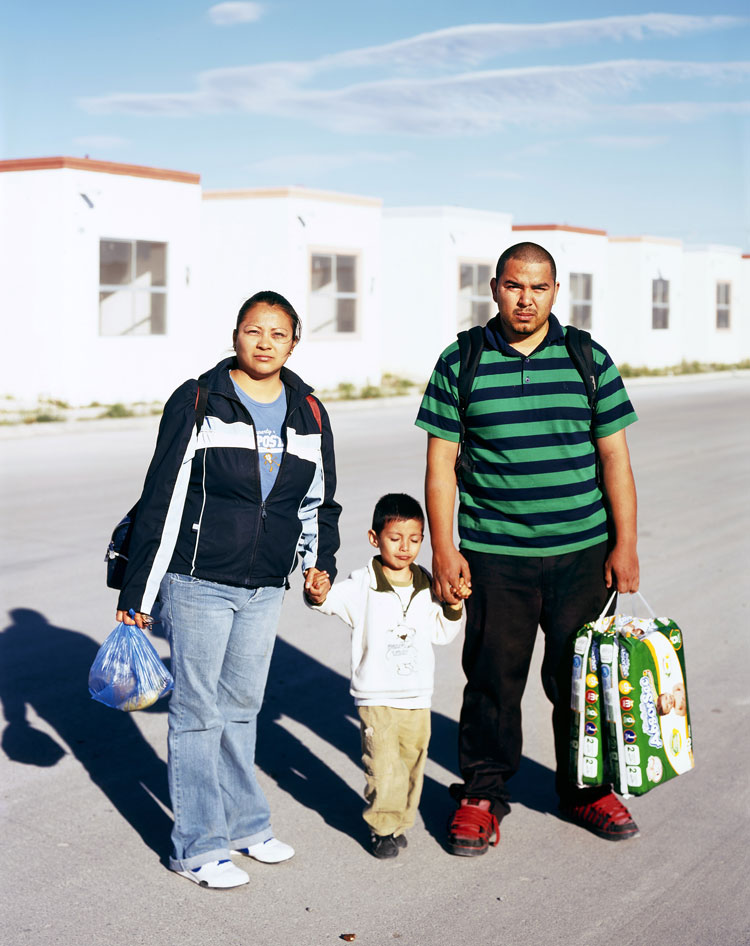
Alejandro Cartagena. Family walking home in a suburb in Juárez N.L from A Small Guide to Homeownership, 2020. © Alejandro Cartagena. Courtesy of the artist.
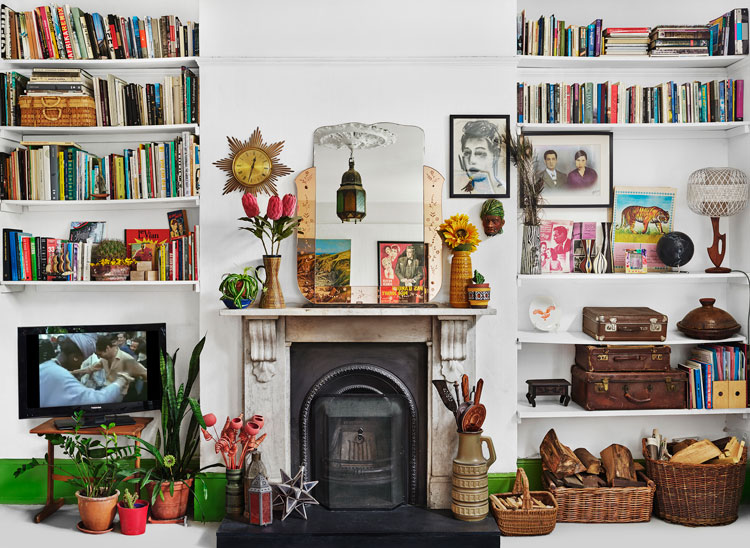
Zineb Sedira. Way of Life, 2019. Exhibition: A Brief Moment, Jeu de Paume, Paris, France. © Zineb Sedira. Courtesy of the artist and Kamel Mennour, Paris.
The 50th anniversary plans have, of course, been hampered by the pandemic and, like so many other institutions, the Photographers’ Gallery has faced financial challenges. “As a charity reliant increasingly on private donations and earned income from admissions, print sales, cafe and bookshop sales, we have been affected financially by the Covid lockdowns,” Rogers says. “We have had to postpone and reschedule many projects and exhibitions, which has caused difficulties for artists and collaborating institutions. Fortunately, we have a group of very loyal patrons and members who have continued to support us, and we have been supported through the Arts Council’s recovery fund. Transferring our programmes online during the pandemic enabled us to reach broader audiences and to innovate with new ways of presenting programmes.” Having realised the importance of the gallery’s virtual offer in reaching and engaging global audiences, Rogers and her team are looking at ways to sustain it into the future. As she explains, like other cultural institutions: “We are still grappling with the obvious problem of how to ensure that while some content must remain free, we can find new ways to sustain the organisation by making some content income generating.”
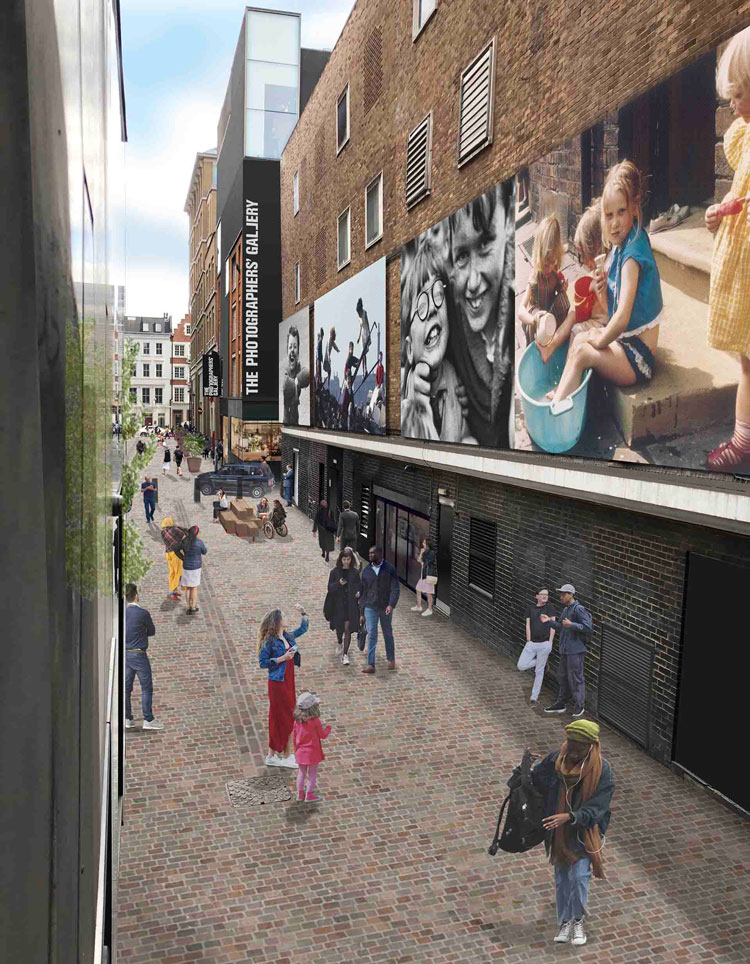
Ramillies Place, Soho, London.
Ever since the Photographers’ Gallery moved into its current space at the intersection of Oxford Street and Soho, Rogers has been looking for ways to capitalise on its prime location. “I foresaw the opportunity to build on our new location at the ‘Gateway to Soho’ by breaking down the physical walls of our building and embracing a new public – people who might casually wander down from the pandemonium of Oxford Street into the more edgy, relaxed atmosphere of Soho,” she says. The ambitious plan, now in its final stages, involves extending the gallery’s exhibition and public events programme into the public realm with the opening of a cultural precinct dubbed the Soho Photography Quarter.
“We have been planning the Soho Photography Quarter for many years, together with the support of Westminster council,” Rogers enthuses. “We are pedestrianising all the roads immediately adjacent to the gallery to create an attractive urban realm in which to display photography and present events during the summer months. This will enable us to connect our indoor and outdoor programme by appropriating walls and spaces in our adjacent streets.” As well as drawing in new audiences, another aim of the project is to raise the profile of Oxford Street’s west end as a cultural destination. “Within five minutes’ walk of the gallery, we are fortunate to have on our doorstep a cluster of outstanding commercial galleries,” Rogers says. “Post-Covid, we know that it is important that we work more closely across the sector to promote the arts and with local stakeholders to restore confidence in attracting people back into the West End.”
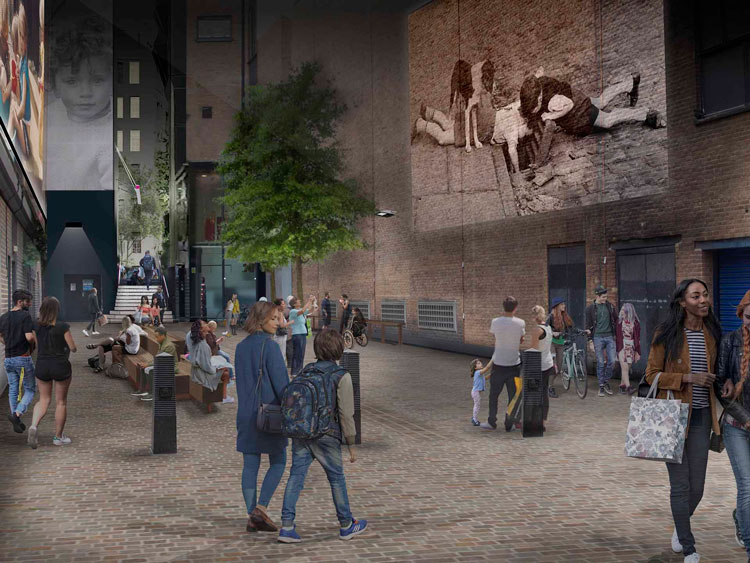
Ramillies Place, Soho, London.
The Soho Photography Quarter’s opening programme is due to launch in the autumn with a selection of moving image works projected across the area’s buildings throughout the night. A more formal launch will follow in February 2022 when the entire pedestrian zone is completed. “Our location just off Oxford Street provides us with a unique opportunity to provide an ‘outdoor lobby’ to attract a new audience into the gallery by engaging them in a similar way to that of Tate Modern’s Turbine Hall,” Rogers says. “This new programme will allow us to further expand the range and diversity of artists we can work with.” The project also reinforces the Photographers’ Gallery’s status as the main platform in the UK solely dedicated to exploring photographic practice. It has certainly has come a long way since its humble beginnings in Covent Garden 50 years ago. There is no doubt that, under the astute directorship of Rogers and her team, the foundations are firmly in place for another half century of inviting, stimulating and informing debate around photography in all its forms.
• Light Years: The Photographers’ Gallery at 50 runs until 1 February 2022. The Deutsche Börse Photography Foundation Prize runs from 25 June 2021 until 26 September 2021.